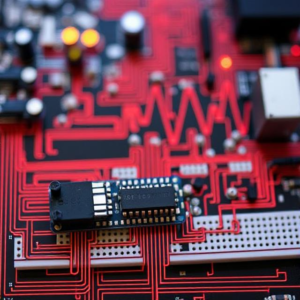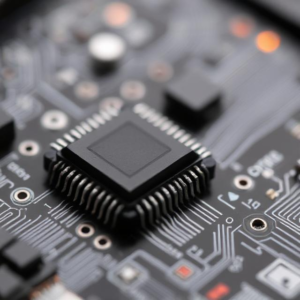What is Signal Conditioning?
Signal conditioning is the process of modifying a signal (usually from a sensor or other electronic device) so that it’s in the right form to be used by other parts of a system, like an analog-to-digital converter (ADC) or a microcontroller. Essentially, it’s about preparing the signal to be read and processed accurately.

Why is Signal Conditioning Needed?
Sensors, like temperature sensors, pressure sensors, or accelerometers, often produce signals that are too weak, noisy, or in the wrong form for the next system (like a computer or microcontroller) to interpret. Signal conditioning circuits fix these issues so that the signal can be properly processed.
For example, a temperature sensor might produce a tiny voltage that’s hard to read. The signal conditioning circuit would amplify this voltage so it’s easier to detect and measure.
What Types of Problems Does Signal Conditioning Fix?
- Amplifying Weak Signals: Many sensors produce weak signals that need to be amplified so they can be processed.
- Filtering Noise: Sometimes the signal contains unwanted “noise” (random fluctuations) that can mess up the measurements. Signal conditioning can filter out this noise.
- Converting Signal Types: Some sensors might output signals in one form (like a current) and the system needs a different form (like a voltage). Signal conditioning can convert between these forms.
- Level Shifting: If the sensor’s signal range is not compatible with the system’s input range, signal conditioning can shift the signal up or down to the right level.
Key Components of Signal Conditioning Circuits:
- Amplifiers:
- These increase the strength (amplitude) of weak signals. For example, a Operational Amplifier (Op-Amp) is commonly used for this.
- Amplifiers are used to ensure that the signal is strong enough to be accurately processed by the system.
- Filters:
- Filters remove unwanted parts of a signal, such as noise (unwanted fluctuations) or high-frequency components.
- Common filter types include:
- Low-pass filters (let through low-frequency signals and block high frequencies).
- High-pass filters (let through high-frequency signals and block low frequencies).
- Band-pass filters (only let through a specific range of frequencies).
- Analog-to-Digital Conversion (ADC):
- If the system is digital (like a microcontroller), the signal may need to be converted from analog to digital. Signal conditioning circuits help make sure the signal is ready for an ADC to do the conversion.
- Voltage or Current Converters:
- If the sensor outputs a current, but the system needs a voltage, or vice versa, signal conditioning can convert between these two forms. Current-to-voltage converters or voltage-to-current converters are used for this.
- Level Shifters:
- If the signal’s voltage is too high or too low for the next stage of the circuit, level shifters adjust the voltage to a proper range.
- Isolation:
- Some systems need to be isolated from high voltages or noisy systems. Optocouplers or transformers can be used in signal conditioning circuits to provide isolation, keeping the sensitive parts of the system safe.
Common Types of Signal Conditioning Circuits:
- Amplifier Circuit:
- This circuit increases the strength of the signal so that it can be more easily read and processed. A common type of amplifier used in signal conditioning is the operational amplifier (Op-Amp).
- Example: If you have a temperature sensor that produces a very small voltage, the amplifier boosts that voltage so it can be measured.
- Filter Circuit:
- Filters remove unwanted noise or specific frequency ranges from a signal. You might use a low-pass filter to remove high-frequency electrical noise from a sensor’s output.
- Example: A sensor might pick up a lot of electrical noise from nearby machinery. A filter can clean up that noise, making the signal more accurate.
- Differential Amplifier:
- This circuit amplifies the difference between two signals, which is useful when you need to measure the difference between two sensor readings or two points in a system.
- Example: A differential amplifier can be used to measure the difference between the temperature readings at two different points in a process.
- Signal Isolation Circuit:
- These circuits are used to separate different parts of a system, often to protect delicate equipment from high voltages or noisy environments.
- Example: If you’re measuring temperature in a high-voltage system, an isolation circuit can protect the measurement system from dangerous spikes in voltage.
Simple Example of a Signal Conditioning Circuit:
Let’s take a temperature sensor as an example. Imagine the sensor outputs a small voltage, but the voltage is too weak to be detected by a microcontroller. Here’s how a signal conditioning circuit can help:
- Amplification: A non-inverting amplifier using an operational amplifier (Op-Amp) boosts the small voltage from the sensor.
- Filtering: A low-pass filter can be added to remove any high-frequency noise from the sensor’s signal.
- Level Shifting: If the voltage from the sensor is outside the range the microcontroller can read (let’s say the microcontroller needs between 0-5V), a level shifter can adjust the signal to the correct level.
- Analog-to-Digital Conversion: Finally, the amplified, filtered, and level-shifted signal can be sent to an ADC (Analog-to-Digital Converter) to be read by the microcontroller.
Benefits of Signal Conditioning:
- Accuracy: Signal conditioning ensures that the signal is clear, strong, and in the right form, which improves the accuracy of the measurements.
- Noise Reduction: By filtering out noise, signal conditioning helps avoid incorrect readings and ensures reliable data.
- Compatibility: It helps ensure that the sensor’s signal can be read by the next part of the system, whether that’s an ADC or a digital system.
- Protection: In some cases, signal conditioning circuits can isolate sensitive equipment from dangerous signals, protecting the system.
Conclusion:
Signal conditioning circuits are essential for modifying sensor signals so they can be properly processed by other parts of a system, like a microcontroller or an ADC. They can amplify weak signals, filter out noise, convert between signal types, shift voltage levels, and even provide isolation. Without signal conditioning, the raw output from sensors may be too noisy, weak, or in the wrong format to be useful.











